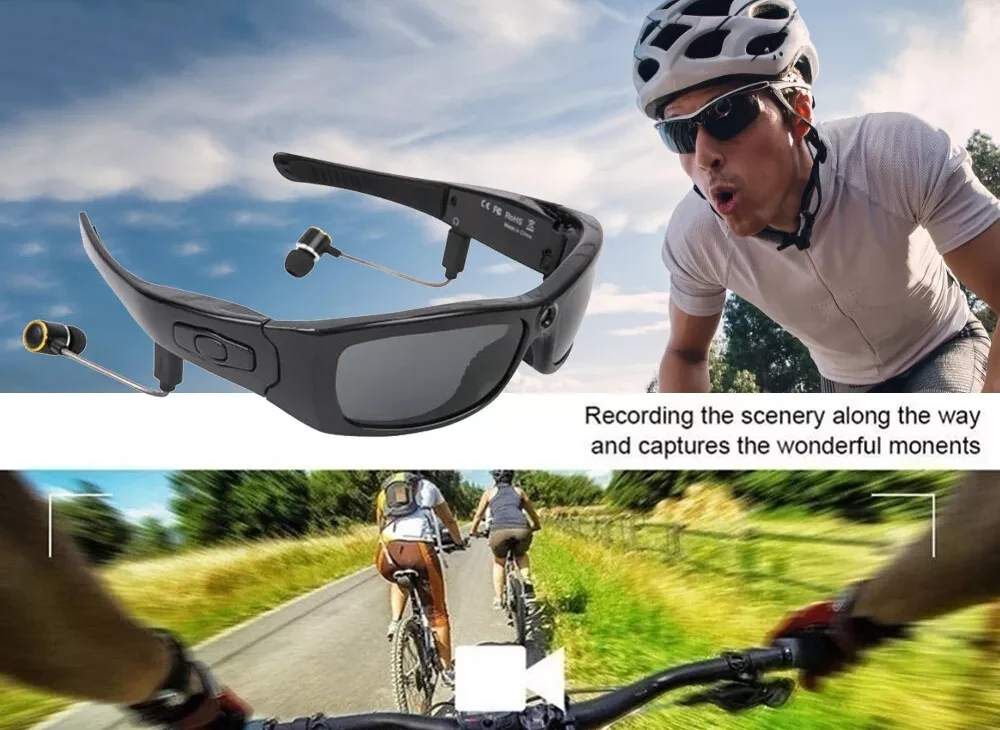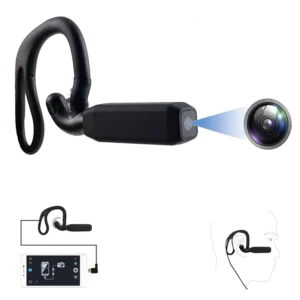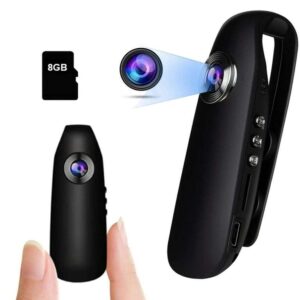Wearable cameras for cycling enhance safety and capture memorable rides. They are essential for documenting incidents and enjoying scenic routes.
Cycling enthusiasts increasingly use wearable cameras to record their journeys. These compact devices easily attach to helmets or handlebars, providing a first-person perspective. They offer clear footage, crucial for evidence in accidents or disputes.
Modern cameras feature high-definition recording, image stabilization, and long battery life, ensuring reliable performance. With waterproof and durable designs, they withstand various weather conditions.
Cyclists can review their rides, share adventures on social media, and improve their skills by analyzing footage. Wearable cameras blend safety with enjoyment, making them a valuable accessory for any serious cyclist.
Introduction To Wearable Cameras
Wearable cameras have become popular among cyclists. These devices record journeys, capture scenic routes and ensure safety. Cyclists can now document their rides effortlessly.
Purpose And Benefits
Wearable cameras serve multiple purposes:
- Safety: Recording incidents can provide evidence.
- Training: Analyzing footage helps improve cycling techniques.
- Memories: Capturing scenic routes creates lasting memories.
These cameras offer several benefits:
- Hands-free operation: Cyclists can focus on riding.
- High-quality footage: Most cameras record in HD or 4K.
- Durability: Designed to withstand weather and rough terrains.
Popular Models
Some popular wearable camera models include:
| Model | Key Features | Price Range (USD) |
| GoPro Hero 12 Black | 5.3K60 & 4K120 video, HyperSmooth 6.0 stabilization, 10-bit color, waterproof (33ft), built-in horizon lock | $400 – $500 |
| Insta360 X3 | 360° 5.7K video, AI editing, FlowState stabilization, waterproof (33ft), touchscreen | $450 – $500 |
| DJI Osmo Action 4 | 4K120 HDR video, 1/1.3″ sensor for low light, RockSteady 3.0+ stabilization, magnetic mount, waterproof (59ft) | $400 – $500 |
| GoPro Max | 360° 6K video, Max HyperSmooth, horizon leveling, waterproof (16ft), vlogging features | $450 – $500 |
| Akaso Brave 8 | 4K60 video, dual-color screens, image stabilization, 170° wide-angle lens, waterproof (33ft with case) | $250 – $300 |
| Garmin VIRB Ultra 30 (Legacy Model) | 4K30 video, GPS, voice control, 3-axis stabilization, waterproof with case | $300 – $400 |
| Sony RX0 II | 4K video, 1” sensor, ZEISS lens, flip-up screen, ultra-compact, waterproof (33ft) | $500 – $700 |
Each model offers unique features to cater to different needs. Choose one that fits your cycling activities best.
Essential Features
Wearable cameras for cycling are increasingly popular. They capture your ride in detail. But, not all cameras are created equal. Knowing the essential features helps you choose the best one.
Durability And Weather Resistance
Durability is key for wearable cameras. They must withstand bumps and falls. Cycling often involves unpredictable weather. Rain or shine, your camera must function well. Look for waterproof and dustproof models.
Consider the build quality. Sturdy materials like aluminum or reinforced plastic offer better protection. Also, check the camera’s shock resistance. It should handle rough terrains easily.
Battery Life
Battery life is crucial for long rides. A good camera should last several hours. Aim for a battery that offers at least 4-6 hours of recording time.
Some cameras come with removable batteries. This feature allows you to carry spares. You can swap them out during long trips. Also, look for fast charging capabilities. This ensures your camera is ready quickly.
Here’s a quick comparison:
| Feature | Importance | Recommendation |
|---|---|---|
| Durability | High | Aluminum or reinforced plastic build |
| Weather Resistance | High | Waterproof and dustproof |
| Battery Life | High | 4-6 hours or more |
Choosing the right features ensures a smooth and enjoyable ride. With the right camera, you capture every moment, no matter the conditions.
Mounting Options
Choosing the right mounting option for your wearable camera is essential for cyclists. It ensures stability, optimal angle, and safety during rides. There are various mounting options available, each with its own set of advantages and considerations.
Here, we explore the popular choices: Helmet Mounts and Handlebar Mounts.
Helmet Mounts
Helmet mounts offer a unique perspective, capturing the rider’s view. This mount keeps the camera steady and aligned with the cyclist’s head movements. Helmet mounts are especially useful for recording trails and routes.
- Visibility: Provides a clear, unobstructed view of the road.
- Stability: Moves with the rider, reducing jerky footage.
- Safety: Keeps the camera away from the bike’s moving parts.
Helmet mounts can be attached using adhesive pads or straps. Ensure the mount is secure to avoid any accidents or camera loss.
Handlebar Mounts
Handlebar mounts are another popular choice for cyclists. They provide a different perspective, capturing the bike’s movement and the cyclist’s hands. Handlebar mounts are ideal for those who want to focus on the journey’s dynamics.
- Accessibility: Easy to reach and adjust while riding.
- Versatility: This can be used on various bike types.
- Stability: Offers a fixed, stable position for the camera.
Handlebar mounts are usually clamped onto the bars. They come in various sizes to fit different handlebar diameters. Ensure the mount is tight to prevent it from shifting during the ride.

Credit: www.walmart.com
Safety Considerations
Using a wearable camera while cycling can enhance your ride. It captures memorable moments and ensures safety. But, you must consider some safety aspects.
Visibility And Distraction
Visibility is crucial for cyclists. Wearable cameras should not block your view. Place the camera in a spot that keeps your vision clear.
Distractions can lead to accidents. The camera should not distract you while riding. Ensure the device is easy to use and adjust.
| Safety Feature | Consideration |
|---|---|
| Camera Placement | Keep it out of your line of sight. |
| Ease of Use | Ensure it’s simple to operate. |
Legal Aspects
Different regions have various laws for wearable cameras. Knowing local regulations is crucial. Some places restrict camera use during rides.
Recording in public can raise privacy issues. Always respect others’ privacy while filming.
- Check local laws before using a camera.
- Avoid recording in restricted areas.
- Respect privacy in public places.
Adhering to these rules ensures a safe and legal ride. It also prevents potential fines or legal issues.
Video Quality
When choosing a wearable camera for cycling, video quality is crucial. Clear and detailed videos enhance your experience and capture every moment. Let’s explore the key factors that affect video quality.
Resolution And Frame Rate
The resolution of a camera determines the clarity of your videos. Higher resolution means more detail. Common resolutions include:
- 1080p (Full HD) – Good for most uses
- 1440p (Quad HD) – Better for more detail
- 4K (Ultra HD) – Best for highest clarity
Frame rate affects how smooth your videos look. Higher frame rates capture more frames per second (fps). Common frame rates are:
- 30 fps – Standard for regular videos
- 60 fps – Smoother for fast actions
- 120 fps – Best for slow-motion videos
For cycling, a resolution of 1080p with 60 fps is ideal. It balances clarity and smoothness.
Low Light Performance
Cycling doesn’t always happen in perfect daylight. A camera’s low light performance is essential for evening rides. Look for features like:
- Large aperture – Lets in more light
- Image stabilization – Reduces blurriness
- Noise reduction – Improves video clarity
These features ensure your videos remain clear even in low light. A camera with good low light performance is a must for night riders.
Data Storage
Data storage is crucial for wearable cameras for cycling. You need a reliable way to keep your footage safe. Two main options are available: memory cards and cloud storage. Let’s explore each option.
Memory Cards
Memory cards are popular for storing video footage. They come in various sizes and speeds. Common types include SD cards and microSD cards.
- Capacity: Choose from 32GB to 512GB or more.
- Speed: Higher speed cards help with smooth recording.
- Durability: Look for cards that are waterproof and shockproof.
Using memory cards is simple. Insert the card into your wearable camera. Once full, transfer files to your computer. This method is cost-effective but requires regular maintenance.
Cloud Storage
Cloud storage offers a modern solution for video storage. It provides remote access to your footage. This method ensures your data is safe even if the camera is damaged.
- Automatic Uploads: Many cameras support automatic uploads to the cloud.
- Accessibility: Access your footage from any device with the internet.
- Security: Cloud storage services often include robust security features.
Cloud storage is convenient. It eliminates the need for physical storage. Consider the costs, as some services require monthly fees.
Editing And Sharing
Editing and sharing your cycling adventures has never been easier. With wearable cameras, you can capture every thrilling moment. After recording, you can edit your footage and share it with friends and followers.
Software Tools
There are many software tools available for editing your cycling videos. Some popular options include:
- GoPro Quik: Easy to use and offers quick edits.
- Adobe Premiere Pro: Professional-level editing software.
- iMovie: Great for beginners and Apple users.
These tools help you trim, cut, and add music to your videos. They also offer features like slow motion and transitions to make your footage look professional.
Social Media Integration
Sharing your cycling videos on social media is a breeze. Most editing software includes options for direct upload. Here are some platforms where you can share:
- YouTube: Ideal for longer videos and vlogs.
- Instagram: Perfect for short clips and stories.
- Facebook: Great for sharing with friends and family.
These platforms help you reach a larger audience. You can also join cycling communities and share your experiences.

Credit: www.amazon.com
User Reviews
When choosing a wearable camera for cycling, user reviews are invaluable. Real-world experiences help potential buyers make informed decisions. Below, we explore the pros and cons and some authentic user experiences.
Pros And Cons
| Pros | Cons |
|---|---|
|
|
Real-world Experiences
John M. from California praises the GoPro Hero 9. He says it offers excellent video quality. He finds it easy to mount on his helmet. John appreciates its durability during rough rides.
Susan L. from New York shares her experience with the Garmin VIRB Ultra 30. She loves its compact design and ease of use. She mentions a downside: the battery life could be longer. But the overall performance impresses her.
Mark T. from Texas uses the Akaso Brave 7. He highlights its affordability and good video quality. Mark finds the storage capacity limited but manageable with extra SD cards.
User reviews offer a wealth of information. They highlight both the strengths and weaknesses of wearable cameras. This helps you make an informed choice when buying a camera for cycling.
Future Trends
The world of wearable cameras for cycling is evolving rapidly. Future trends show exciting advancements that promise better experiences for cyclists. Let’s delve into the upcoming technological innovations and market predictions.
Technological Innovations
Wearable cameras are embracing cutting-edge technology. AI-powered features offer real-time object detection. Cameras will alert cyclists about potential hazards. Enhanced image stabilization ensures clearer and smoother footage. This is crucial for documenting rides on rough terrains.
Compact and lightweight designs are also emerging. These make cameras less obtrusive and more comfortable to wear. Cyclists can focus on their ride without feeling burdened. Improved battery life is another key trend. Longer rides can now be recorded without worrying about the battery dying.
Integration with other smart devices is becoming standard. Wearable cameras will sync effortlessly with smartphones and smartwatches. This allows for easy access and sharing of recorded content. Voice control features are also gaining popularity. Cyclists can operate their cameras hands-free, enhancing safety and convenience.
Market Predictions
The market for wearable cameras is expected to grow. Increased demand among cycling enthusiasts is a driving factor. Competitive pricing will make these cameras accessible to more people. Enhanced marketing strategies will also play a role in market expansion.
| Year | Market Size (in billion USD) |
|---|---|
| 2023 | 1.5 |
| 2024 | 2.1 |
| 2025 | 2.8 |
Innovative marketing campaigns will target younger audiences. Social media influencers will play a significant role. Collaborations with cycling brands will boost visibility. These trends ensure that wearable cameras will become a staple for every cyclist.
Customizable features will attract more users. Cyclists can personalize their cameras to fit their needs. This will lead to higher customer satisfaction and loyalty. Sustainable and eco-friendly materials will also be in demand. Companies will focus on producing environmentally friendly products.

Credit: www.amazon.com
Frequently Asked Questions
What Is The Best Camera For Cycling?
The best camera for cycling is the GoPro Hero11. It offers excellent image stabilization, high resolution, and durability.
Should Cyclists Wear A Camera?
Cyclists should wear a camera for safety and evidence in accidents. It helps document incidents and deters aggressive drivers.
Is A Cycling Camera Worth It?
Yes, a cycling camera is worth it. It enhances safety, provides evidence in accidents, and captures memorable rides.
What Is The Best Gopro For Biking?
The GoPro Hero11 Black is the best for biking. It offers excellent stabilization, high-resolution video, and durable design.
Conclusion
Cycling with wearable cameras enhances safety and captures memorable moments. These devices are easy to use and reliable. Investing in a quality camera can make a significant difference. Cyclists can enjoy their rides while feeling secure.
Embrace technology and elevate your cycling experience with a wearable camera today.

A passionate tech blogger and the founder of Best Tech View, a dynamic platform dedicated to all things technology. With a keen interest in the tech, Ahmad strives to provide insightful and engaging content on the latest tech trends, and breakthroughs.



